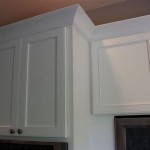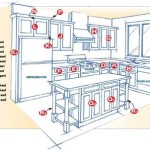Stripping Stain from Kitchen Cabinets: A Comprehensive Guide
Kitchen cabinets often undergo various changes in color and finish over time due to aging, wear and tear, or a desire for a fresh look. Stripping the existing stain can be an effective way to restore or refinish your cabinets, allowing you to achieve the desired aesthetic. Here's a comprehensive guide on how to strip stain from kitchen cabinets.
Materials Required:
- Chemical stripper
- Plastic scraper
- Steel wool
- Tack cloth
- Mineral spirits
- Sandpaper (120-grit and 220-grit)
- Vacuum cleaner
- Safety mask
- Gloves
Safety Precautions:
Before starting, it's crucial to take the necessary safety precautions:
- Wear a safety mask and gloves throughout the process.
- Work in a well-ventilated area or outdoors to avoid inhaling harmful fumes.
- Cover the surrounding surfaces with drop cloths to protect them from splashes.
Step-by-Step Instructions:
1. Remove Cabinet Doors and Hardware:
Remove all cabinet doors and hardware, such as handles and hinges.
2. Apply Chemical Stripper:
Apply a chemical stripper to the surface of the cabinets using a brush or sprayer. Follow the manufacturer's instructions for application and dwell time.
3. Scrape Off Old Stain:
Once the chemical has had sufficient time to work, use a plastic scraper to carefully scrape away the softened stain. Avoid using metal scrapers, as they can damage the cabinets.
4. Clean with Mineral Spirits:
Use mineral spirits to clean the surface of the cabinets and remove any remaining stain residue. Wipe down the cabinets with a tack cloth to remove any dust or debris.
5. Sand the Cabinets (Optional):
For a smoother finish, sand the cabinets using 120-grit sandpaper, followed by 220-grit sandpaper. Vacuum off any sanding dust.
6. Reassemble and Seal:
Once the cabinets are completely dry, reassemble them and attach the hardware. Seal the cabinets with a polyurethane finish to protect the surface and enhance durability.
Tips:
- Test the chemical stripper in an inconspicuous area before applying it to the entire cabinets.
- Work in small sections to prevent the chemical stripper from drying out.
- Dispose of the chemical stripper and rags properly according to manufacturer's instructions.
- Allow ample time for the cabinets to dry thoroughly before applying a new finish.
- For painted cabinets, you may need to use a stronger stripper or sand the surface to remove the paint completely.
Conclusion:
Stripping stain from kitchen cabinets can be a rewarding project that can transform the look of your kitchen. By following these steps and taking the necessary safety precautions, you can effectively remove old stain and prepare your cabinets for refinishing. Remember to choose the appropriate stripper, test it before applying, and allow ample time for drying before applying a new finish.

How To Strip And Re Stain Kitchen Cabinets Clinton Township Mi Eason Painting

Staining Your Wood Cabinets Darker Young House Love

An Easier Way To Remove Paint From Wood
:strip_icc()/103081211-6eeaaa24eefe46f9987249bf6712aa00.jpg?strip=all)
Our Step By Guide To Beautiful Stained Wood Cabinets

How To Strip Paint Off Kitchen Cabinets And Furniture

How To Lighten Stained Wood 7 Options That Work Grace In My Space

How To Clean Kitchen Cabinets Everyday Skate

How To Make Rustic Kitchen Cabinets By Refinishing Them The Best Stain Color Amanda Katherine

How To Strip Stain From Old Kitchen Cabinets Doityourself Com

How To Remove Paint Or Stain From You Kitchen Cabinets Part 1
Related Posts








